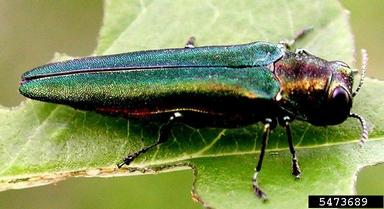 What is EAB, or the Emerald Ash Borer?
What is EAB, or the Emerald Ash Borer?
The Emerald Ash Borer is a very small shiny green beetle about 1/2" long by 1/8" wide. This invasive insect feeds on the cambium tissue of ash (Fraxinus) trees. Once infested the tree begins to decline after 2 years and will be dead in the next 4 years. Once the tree is dead it becomes hazardous due to a threat of falling limbs and trunk.
How did EAB Get Here?
The Emerald Ash Borer originates from central Asia, in countries such as Russia, China, and Mongolia. It is believed the insect was brought to this country in wood packaging material. It was first discovered in Detroit, MI in 2002 but is believed to have been here since the mid 1990's. Since its discovery in 2002, it has spread to 24 states and 2 Canadian provinces. The insect is believed to have been predominantly transported by the movement of firewood.
What is the City doing about EAB?
Knowing the insects pattern, the City activated its EAB response plan five years ago when EAB infestation was identified just 80 miles from Davenport in LaSalle, IL. During that five year period identification of EAB infestation came closer and closer to Davenport, with identification in Cedar County in 2013 and Muscatine and Rock Island (IL) counties in 2014. EAB was identified in Davenport in the Spring of 2015.
Activation of the EAB response plan means:
- The city continually monitors presence of the pest.
- The ash tree removal process has started. Initial steps to reduce infestation included targeted removal of public ash trees in the worst condition, followed by removal of groups of ash trees in close proximity to each other.
- Reducing the impact of ash tree removal (loss of tree canopy) by implementing an aggressive tree planting program. Nearly 2,200 trees have been planted in the city right-of-way in the past five years.
The City is not preserving public ash trees with EAB treatments due to the expense and benefit of treatment. Citizens interested in preserving city trees in the boulevard adjacent to their home, may treat these trees at their own expense. Citizens wishing to treat trees should apply for a permit to treat the city-owned tree(s). This allows the city to track what trees are receiving treatment, the chemical used, who treated the tree, and when it was treated. The permit also ensures the tree will not be cut down by forestry crews. Listing of contractors permitted to treat public ash trees in the city.
For private trees, the city recommends citizens first determine if they have an ash tree on their property and then decide whether to treat the tree for the remainder of its life or to remove it. The city's arborist recommends contacting an ISA Certified Arborist for help determining a course of action.
Citizens who decide to remove their tree will need to abide by the quarantines set by the Iowa DNR and USDA's Animal and Plant Health Inspection Service (APHIS). When removed, citizens are encouraged to take their wood waste to the City's Compost Facility. Wood waste is accepted at no charge.
Find answers to Frequently Asked Questions produced by Iowa State Extension and Outreach at this link.
Don't Move Firewood. Moving firewood poses the greatest threat of spreading EAB further.